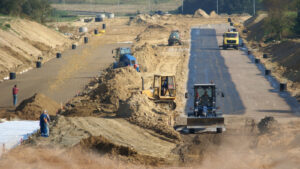We all want to be safe drivers, but safety isn’t something that lies entirely in our own hands. Although the construction of roads has made transportation much easier, it must not be forgotten that human safety is also at the forefront. Many roading catastrophes are occurring in Australia that could lead to the fatality of many. From weather failure to poor driving behaviour, this article will discuss the 5 causes of roading catastrophes in Australia. Read on to discover the technological solutions that can help maintain safer roads.
Reasons for Roading Catastrophes in Australia
There are many causes of car accidents. However, some occur more often than others. Here are 5 reasons that lead to road accidents in Australia:
Weather Failure
It is anticipated that climate elements, such as widening temperature ranges and increased severity of inclement weather, will have a substantial impact on not just the road transportation system but also on driving behaviour and road safety. One environmental risk factor known to impact the number of traffic accidents in Australia and elsewhere is the weather. Road safety is seriously threatened by weather that lessens friction on the road, lowers visibility, and/or makes vehicle handling more challenging. According to research, inclement weather raises the likelihood of crashes, indicating that drivers’ adaptations to the weather are insufficient to fully counteract the risks brought on by lower road friction and poor vision.
Poor Road Maintenance
The safety of all road users, including the general public and the truck drivers who transport the majority of our goods and products throughout Australia, depends on ongoing road maintenance services. In addition to endangering lives and bringing misery to many families and local communities, poor road maintenance also imposes an increased burden on the hospital system, which may have to provide long-term care for accident victims. Road maintenance is essential to learn about any deteriorating road infrastructure, especially on motorways and other fast-moving routes where accidents are more prone to happen.
Failing Road Infrastructure
It is possible that decaying infrastructure is not always discovered when undertaking routine road maintenance. Unchecked issues with the road infrastructure could result in many accidents, some of which could be fatal. Poor infrastructure includes things like shaky roads, uneven construction, and fractures in the pavement. These flaws might result in car accidents as well as other issues like tyre punctures that might ultimately result in accidents. This emphasises the importance of spotting decaying road infrastructure as soon as it happens.
Poor Vehicle Maintenance
It was not always possible for drivers to keep their cars up to code. Failure to maintain a vehicle in excellent working order can lead to accidents and injuries. Accidents may be the result of basic vehicle maintenance and repairs being neglected. Along with increasing the life of the vehicle, regular maintenance helps keep drivers, passengers, and other road users safe. For instance, having strong brakes makes it possible to stop quickly to prevent a collision. Braking failure is one of the leading reasons for rear-end crashes. Many things, such as damaged brake lines, worn brake pads or rotors, and defective anti-lock braking systems, can lead to brake problems.
Poor Driving Behaviour
Unsafe driving practices have the potential to kill both the driver and other nearby drivers. When motorists combine many risky behaviours while driving, it can be very hazardous. Here are 3 reckless driving habits that might result in fatal traffic collisions:
- Distracted driving – It is vital to focus your attention on the road and what is occurring around your vehicle when driving to avoid allowing distractions to cause an accident.
- Speeding – Always follow the posted speed limits. Adjust your speed to the environmental conditions and traffic conditions around you to ensure your safety.
- Driving too fast for weather conditions – Always adjust your driving speed for the conditions that are present. When possible, schedule travels around weather conditions that lead to dangerous driving conditions.
Technologies that Can Prevent Future Roading Accidents
The ability of fleets to combine technology and safety in 2022 will be one of their main problems. Existing fleets frequently lack essential components that may save lives. Consumer cars now come standard with backup cameras, numerous lane departure sensors, and seat-belt sensors, but fleets are not all using the same safety technology. Fortunately, things are starting to change. Here are the top 5 technologies that will significantly contribute towards safer roads in Australia:
Satellite Data Analytics
The long-term criticality, performance decreases, structural deterioration, and operational deterioration of transportation infrastructure that spans enormous land footprints of 120,000 KM can all be detected by InSAR technology. By analysing social factors such as road usage, demographic information, community impacts, and others, Satellite Data Analytics can assess the viability of investing in transportation systems and infrastructure thanks to advanced remote signalling and wide-range accessibility to civilian radar satellites circling in space.
The transportation service’s use of satellite data analytics also enables agencies to identify slope instability, isolate landslide-prone areas, and maintain a close watch over such locations to ensure the safety of people walking, driving, using public transportation, using natural resources, owning property, and living there. Additionally, it uses remote satellite data to identify other dangerous dangers like sinkholes, which may be successfully exploited by satellite data analytics tools to carry out continuous monitoring of all assets in the transportation system.
Sensor Technology
Managers of transportation assets are familiar with a wide range of sensors, including video sensors, accelerometers, laser scanners, and more. Advanced spatial data-based techniques are embedded into sensor technology to assess the health of transportation assets. For instance, the laser line sensors built into our fleet of IIoT-powered inspection robots can quickly find shoving, rutting, and other flaws in the road’s surface.
Sensor networks make sure that even the smallest structural or operational flaw is not noticed in your transportation asset. To get more insights into road failures and better, more flexible ways to regulate them with reasonable financial investment ranges, the sensor-based data of this equipment is later processed and visualised in 2D or 3D models of transportation assets. For future-proof asset decisions, sensor technology can automatically handle asset condition restrictions and forecast transportation asset failure patterns.
Digital Twin
The current state of your assets will be represented in an editable and interactive digital model thanks to digital, which allows for precise and proactive inspections. Consider a scenario in which the user needs to address real-time traffic patterns, pavement and surface characteristics, and the present weather. They can then easily alter the 3D model to collect all asset-centric data.
Additionally, Predictive and Prescriptive Analytics Technologies enable Digital Twin Technology to visualise future parametric data, statistics, and asset condition information based on the insights produced by tried-and-true AI models. Consequently, this model also allows for the visualisation of impending deterioration patterns, risks, failures, and maintenance requirements.
The Digital Twin Model is improved by simulation technology to simulate asset conditions and behaviours in diverse contexts. To learn how assets behave in particular potential incidents and observe how the asset evolves as a result of these events, transportation infrastructure managers need to modify data sizes.
Predictive and Prescriptive Analytics
Predictive technology offers data regarding transportation asset degradations that, if not caught in time, may negatively result in unanticipated expenses, downtime, losses, or even injuries. Through the quantification of potential hazards, delays, failures, and subpar performances, this technology expedites preventive and intelligent maintenance routines during off-peak times. By doing this, you can prevent service interruptions for your transportation system and unanticipated asset failure. Furthermore, predictive analytics can help road asset management identify and address any reckless driving on the part of any driver, leading to fewer accidents, lower costs, and higher participation.
The predictive technology’s projected parameters, statistics, and data set are used to educate the prescriptive technology to tailor asset condition-based risk, cost, and performance initiatives. Because they automatically visualise predicted asset data in a consolidated and cutting-edge manner, such as via smart dashboards, digital twins, and GIS maps, predictive and prescriptive analytics technologies have propelled contributing independent users to use self-adaptive systems, making them the most admired analytics technology for the majority of transportation asset managers.
IIoT
The administration and upkeep of transportation assets are greatly aided by IIoT technology. As a result of more expedient and intelligent asset data gathering, standardisation, and analytics, transport asset managers get the ability to be more productive, updated, and unchallenged. To best serve your transportation utility organisation, IIoT provides affordable sensor fleets, CCTV and laser equipment spreads, smart metre networks, and other equipment.
This solution will hasten the improvement of management, maintenance, and revamping of transportation infrastructure in a data-driven, condition-based manner, regardless of how complicated your transportation infrastructure may be. It enhances real-time condition monitoring by giving quick visibility to the operational and conditional states of all transportation assets around the city. This makes the IIoT technology a crucial part of your road safety procedures.
Make Your Roads Safer with Industry 4.0
When it comes to enhancing road safety, the car sector has made significant progress. In the past, innovation only extended to adding airbags and seatbelts to cars, but today, cutting-edge technology is available to make our roads significantly safer for both drivers and pedestrians. Nowadays, it is possible to avoid traffic accidents, and drivers have access to cutting-edge technology that lowers the likelihood of them happening. Technology is essential in lowering the risks to workers on the highways. The same is true for road safety, where technology is available to improve driving conditions and make all routes safe. Make your choice to make your roads the safest they have ever been today.







